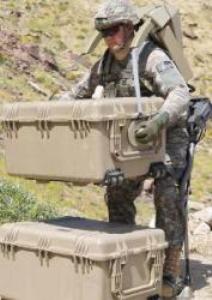Oct 30 2010
Lockheed Martin has commenced validation testing of HULC, the latest robotic exoskeleton. The testing enables HULC to be deployed for helping military troops and for moving bulky loads.
 HULC Robotic Exoskeleton
HULC Robotic Exoskeleton
HULC robotic exoskeleton is activated by hydraulic energy, and the user can perform various activities like crouching, creeping as well as stretching the upper body with less effort. It has been developed to remove the weight from bulky consignments to the floor by the robotic legs of the exoskeleton that envelop the lower body, thereby relieving the operator from the heavy weight. An innovative in-built micro-computer assures that the performance of the robotic exoskeleton is at par with the movements of the operator.
The robust exoskeleton features several layout variations to enhance consistency in functional environments. The latest environmental envelope and casing protects the electronic components from battleground dangers and other natural hazards. HULC includes batteries of high standards, which can be replenished for offering sustained performance during critical operations.
The validation testing covers the abilities and competencies of HULC in multifarious combat situations. Russell, Director of Sensors, Data Links and Advanced Programs at Lockheed Martin Missiles and Fire Control, has stated that all the advancements made in the exoskeleton were cautiously designed to uphold its maximum accomplishment and remove physical exertions that can encumber the success of the mission. He added that the design enhancements applied on HULC will offer risk mitigation for the fighters. The suit has been further improved for enabling the warrior to get quickly accustomed to the exoskeleton. Also the robust layout allows for quick alterations to chest and thigh lengths without requiring distinct tools. Support and comfort are offered by means of lumbar padding. Also the improvised control software can trace the operator’s movements efficiently.
The validations of environmental and biomechanical aspects of the HULC are in progress. The desired lowering of metabolic cost while carrying bulky objects will be determined by treadmill testing. Its sustainability in tough environments and combat resilience will be evaluated by mimicking similar conditions and are achieved by means of wind, sand, temperature and humidity testing methods.